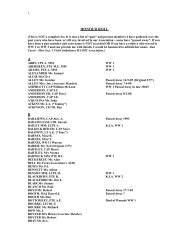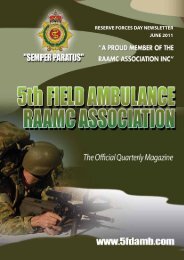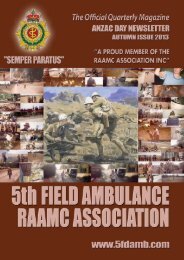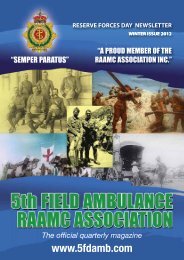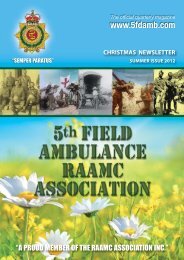2010 Paulatim Magazine - RAAMC Association
2010 Paulatim Magazine - RAAMC Association
2010 Paulatim Magazine - RAAMC Association
You also want an ePaper? Increase the reach of your titles
YUMPU automatically turns print PDFs into web optimized ePapers that Google loves.
Proposed Pathway – Medic to PA<br />
<strong>RAAMC</strong> medics should be able to view progression to PA as a realistic<br />
pathway in their long-term career development. Senior medics should<br />
be expected to either go into training, mentoring and management as a<br />
WO or ASWOC, or strive to undertake PA training to further develop<br />
their clinical skills. Stagnation of these skills at the senior NCO level will<br />
not be an option. The most likely decision point for medics will be once<br />
they reach the rank of SGT. By this stage, medics will have completed<br />
18 months of training through ALTC, followed by at least two years as a<br />
PTE(P) and three years as a CPL. They will therefore have at least five<br />
years of clinical experience once promoted to SGT and possess the<br />
requisite training and experience to apply for entry to the<br />
GCPhysAsstSt.<br />
Medics aspiring to train as PA can then apply for selection into an ‘Army<br />
Physician Assistant Scheme’ (APA), which would operate in a similar<br />
fashion to the current ADF Graduate Medical Scheme. Selection into APA<br />
would be competitive and possibly involve aptitude testing and a panel<br />
interview. Medics who have demonstrated sound clinical abilities and a<br />
commitment to a career in <strong>RAAMC</strong> will receive sponsorship to undertake<br />
the GCPhysAsstSt (or MPhysAsstSt if they meet the previous degree<br />
requirement) through UQ. Ideally, there will be ‘quarantined’ places in<br />
the UQ courses for <strong>RAAMC</strong> medics sponsored through APA, meaning<br />
medics will not need to apply separately to the University.<br />
During their first year in either the GCPhysAsstSt or MPhysAsstSt,<br />
students will only be studying part-time (two courses each semester).<br />
This would allow APA students to continue to work in their current unit.<br />
Alternatively, they could be posted to a medical facility (e.g. HSB or<br />
CSSB) in a supernumerary position. Students would have a reasonable<br />
amount of study time during work hours, as determined by their chainof-command.<br />
Students would have their university tuition and<br />
associated fees paid for through APA and an appropriate textbook and<br />
professional development allowance.<br />
Students in the GCPhysAsstSt stream will be eligible to proceed to the<br />
Master’s program if they achieve a GPA of 5.0 or above. Those that do<br />
not achieve this score, or do not wish to go on to the MPhysAsstSt, will<br />
exit APA with a GCPhysAsstSt and resume their duties in their unit.<br />
The support they received through the scheme would be considered<br />
military-related training and would not attract a Return of Service<br />
Obligation (ROSO).<br />
Students that continue studying towards the MPhysAsstSt will receive<br />
ongoing support through APA. They would undertake long-term<br />
schooling and complete the Part B courses on a full-time basis. They will<br />
continue to receive their current salary, accrue annual and long-service<br />
leave, be eligible for housing support in accordance with their<br />
classification and be covered by ADF medical and dental services.<br />
They will also be required to abide by army directives regarding health<br />
and fitness, use of prohibited substances and travel restrictions. In most<br />
cases, APA students will be able remain in their original posting locality,<br />
with the possibility available for students to post to another region if<br />
clinical rotations required for the Part B courses are not available<br />
locally.<br />
Once graduated from the degree, APA students will be commissioned as<br />
a Specialist Service Officer (SSO) at the rank of LT and be posted to a<br />
large army medical facility as a first year PA with a two-year ROSO.<br />
Non-military PA graduates who did not receive military sponsorship for<br />
their training would also be eligible to apply for direct entry to the<br />
Army as SSOs. During this first year, PA will complete a suite of courses<br />
similar to those undertaken by other <strong>RAAMC</strong> SSOs, including the SSO<br />
course at RMC Duntroon, Logistic Officer’s Basic Course (Health Phase)<br />
and Military Advanced Resuscitation Course (MARC) at ALTC, and<br />
possibly the Early Management of Severe Trauma (EMST) course as<br />
observers.<br />
The <strong>RAAMC</strong> PA<br />
First year PA in the Army would work in large medical facilities, such as<br />
in an HSB, CSSB, or Garrison Health Facility (once implemented).<br />
They would be supervised by a Medical Level 3 or 4 (formally<br />
Competency Levels 3-5) Medical Officer in the unit, who would monitor<br />
their management of patients, write their Performance Appraisal<br />
Reports (PARs) and provide them with informal and formal clinical<br />
training and mentoring. The PA would see patients for sick parade,<br />
take appointments outside of sick parade timings, perform minor<br />
procedures as per their training and skill set, and assist medical officers<br />
in clinical tasks as required. They would also be expected to provide<br />
clinical guidance and training to medics in the unit, and provide medical<br />
planning and support to exercises and activities as tasked by the unit.<br />
There would be opportunities for PA to attend professional development<br />
events, such as conferences and courses, with the approval of their<br />
chain-of-command, and even deploy if operationally required.<br />
Following completion of their first-year ‘orientation’, PA would either<br />
remain at their HSB/CSSB/Garrison Health Facility, or be posted to a<br />
unit, preferably one without a uniformed MO. In this case, they would<br />
be the senior medical provider for the unit. They would continue to<br />
work under the supervision of an MO located in the same region, albeit<br />
remotely. Alternatively, they could be supervised by civilian doctors<br />
providing medical services to their unit, if available. PA would be<br />
expected to meet the healthcare needs of their unit, both in Australia<br />
and on deployment, and be guaranteed access to an MO within a<br />
reasonable timeframe for referral and advice purposes. Supervising<br />
MOs would meet with their PA regularly to directly observe and provide<br />
feedback on their consultations with patients. In the long-term, PA<br />
would progress through the ranks in a similar way to other SSO health<br />
professionals, taking on a managerial, training and/or senior clinician<br />
role. Postings options could include larger medical facilities, the Army<br />
School of Health at ALTC and headquarters positions involving health<br />
planning and policy development.<br />
PAULATIM<br />
PA U L AT I M – M A GAZINE O F T HE R OYA L A U S T R A L I A N A R M Y M E DICAL C O R P S – 2 0 1 0 6 3



